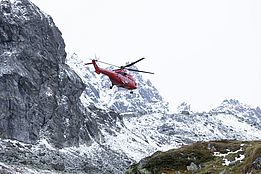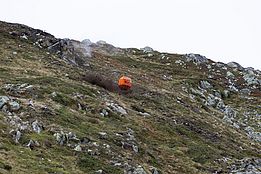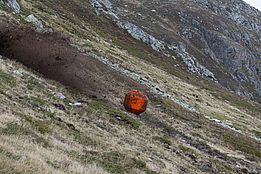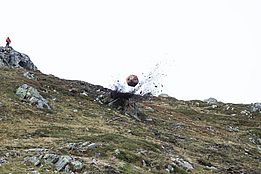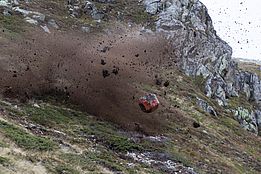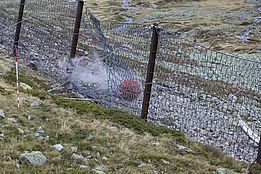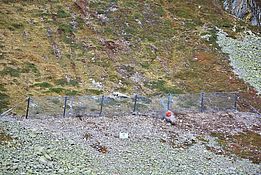14.10.2019 | Claudia Hoffmann | News SLF
SLF researchers are conducting field trials with an industrial partner to optimise the effectiveness of rockfall nets.
A block weighing 2.5 tons is rolled down the slope and crashes into a safety net at full speed. This scenario was tested by SLF researchers and representatives of the company Geobrugg on a slope near Chant Sura by the Flüela Pass. To this end, as in previous experiments, they used concrete blocks of different shapes and sizes, which were set in motion from a platform. For the current series of tests, nets have now been installed additionally at the foot of the slope to measure the blocks' impact forces and deceleration.
The experiments are part of an Innosuisse project intended to promote collaboration between research institutions and companies. The project partners are the SLF and Geobrugg, which wants to test a new version of its existing safety nets in the field. For this purpose, the nets are fitted with sensors to measure the impact forces, while the blocks also contain sensors to measure their rotation and acceleration. High-speed video recordings also provide information about movement patterns during impact. "The aim is to gain new measurement data to refine the nets' construction and improve our rockfall simulation programme", says SLF project manager Andrin Caviezel. This new range of stress tests conducted under real conditions is a valuable addition to the standardised fall tests carried out by the manufacturer.
The shape of the block plays a role
Previous experiments, conducted without nets, already yielded important findings. "Our data show that the shape of the block should not be underestimated in the risk assessment", says Caviezel. For example, wheel-like blocks have a much wider runout zone than cube-shaped ones. On the other hand, the speeds and jump heights of various block shapes barely differ. The measurement data also provide more accurate representations of the blocks' different interaction with soft or hard ground than have been available up to now in the RAMMS::ROCKFALL simulation program.
RAMMS::ROCKFALL is used by engineering firms around the world for risk assessment and the dimensioning of protective structures. So far, it has successfully simulated the runout zones of blocks on the terrain in question. The long-term goal is also to model how blocks interact with safety nets and other protective structures. The current series of experiments will contribute towards achieving this.
Picture gallery (click to enlarge) ¶
